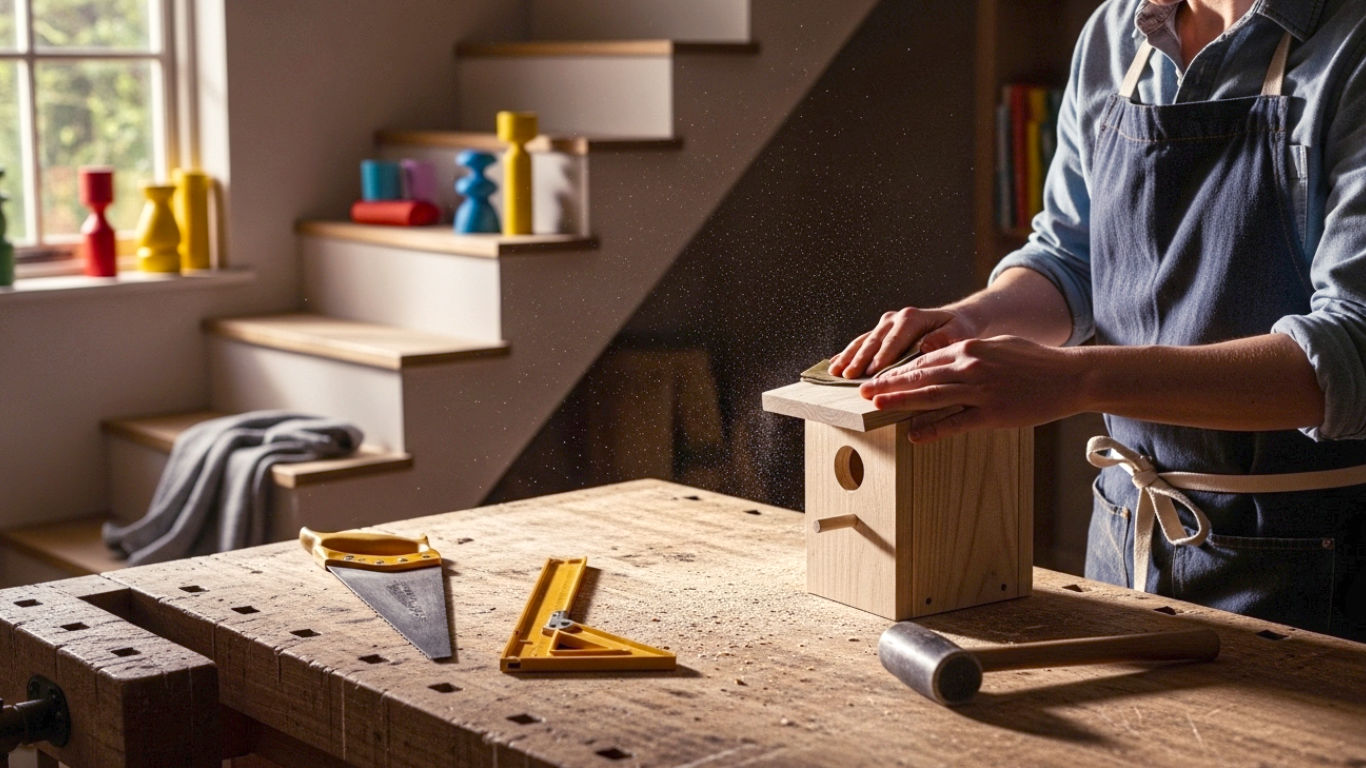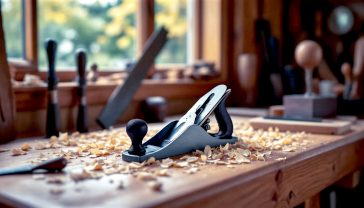DIY Wood Crafts: The Ultimate British Guide to Getting Started
The definitive British guide to DIY wood crafts. Find top project ideas for home and garden, learn essential skills, and get kitted out to start building today.

This post may contain affiliate links. If you make a purchase through these links, we may earn a commission at no additional cost to you.
There’s a special kind of magic in turning a plain plank of wood into something beautiful, useful, or just plain fun. In a world of screens and clicks, the simple act of making something real with your own two hands feels more satisfying than ever. It’s a feeling that’s deeply woven into Britain’s history, from the skilled hands that built Viking longships on our shores to the legendary craftsmanship of Chippendale furniture. Today, that same spirit is alive and well in garden sheds, community workshops, and kitchen tables across the country.
Forget thinking you need a massive workshop and a fortune in tools. That’s a myth. All you really need is a bit of curiosity, a patch of space, and a guide to point you in the right direction. This is that guide. We’ll walk you through everything, from picking your first piece of timber at B&Q to applying the final lick of wax on a project you can be truly proud of. Whether you want to build a simple birdhouse for the garden, a rustic shelf for the living room, or a handmade gift that means the world, you’re in the right place. Let’s get making.
Why Bother with Woodcraft? More Than Just a Plank of Wood
So, why swap your Sunday afternoon scrolling for a bit of sawdust and sanding? Well, the rewards are far greater than just ending up with a new spice rack.
It’s Good for Your Brain (and Your Soul)
Working with wood forces you to slow down and focus. The world outside, with its endless pings and notifications, just melts away. Measuring a line, guiding a saw, feeling the grain of the wood under your fingertips – it’s a form of mindfulness. It’s calming, rewarding, and brilliant for your mental well-being.
Create Things You Actually Need (and Save a Bob or Two)
Ever searched for the perfect small bookshelf for that awkward alcove? Or a bath caddy that actually fits your tub? When you make it yourself, you’re in control. You can create custom pieces that are perfectly tailored to your home and your taste. And let’s be honest, building it yourself is often a lot cheaper than buying it from a posh shop.
Go Green with Reclaimed Wood
Woodcraft is a fantastic way to be more sustainable. You can breathe new life into old materials, from discarded pallets to offcuts from a building site. This kind of upcycling not only saves wood from landfill but also gives your creations a unique character and story that you just can’t buy new.
Could It Be a Side Hustle?
What starts as a hobby can sometimes turn into a nice little earner. There’s a huge appetite for handmade, quality goods in the UK. Selling your creations at local craft fairs, on Etsy, or just to friends and family can be a great way to fund your hobby or even supplement your income.
Getting Kitted Out: Your Beginner’s Guide to Wood and Tools
Before you can start building, you need your raw materials. Getting your hands on wood and a few basic tools is easier and cheaper than you might think.
Where to Find Wood in the UK Without Breaking the Bank
You don’t need to find a specialist supplier straight away. Your first projects can be made with wood from very accessible places.
Big DIY Stores: B&Q, Wickes, and Homebase
These are the obvious starting points. They sell a range of planed (meaning smooth) timber, usually pine, which is perfect for beginners. You can often find smaller, manageable lengths, and they usually have an offcuts bin where you might find a bargain.
Local Timber Merchants: The Hidden Gems
Don’t be intimidated by proper timber yards. These places are treasure troves of wood and knowledge. The staff are often incredibly helpful and can cut wood to the exact size you need, saving you a job. They’re a great place to discover different types of wood once you get more confident.
Reclaimed and Pallet Wood: Free and Full of Character
Keep your eyes peeled for old furniture being thrown out, skips with wooden offcuts, or local businesses getting rid of pallets. A word of caution with pallets: make sure they are stamped with ‘HT’ (heat-treated), not ‘MB’ (methyl bromide), which is treated with nasty chemicals you don’t want in your home. Reclaimed wood often needs a bit of work—removing nails and sanding it down—but the rustic results are well worth it.
Choosing the Right Timber for the Job
Wood is generally split into two camps: softwoods and hardwoods.
- Softwoods (like Pine): This is your best friend when you’re starting out. Pine is cheap, widely available, and easy to cut and sand. It’s perfect for indoor projects like shelves, boxes, and frames.
- Hardwoods (like Oak or Beech): As the name suggests, these are tougher customers. They are more durable, more expensive, and harder to work with. They are beautiful, though, and fantastic for things that will get a lot of use, like chopping boards or small benches. Best to save these for when you’ve got a couple of projects under your belt.
Your First Toolkit: The Bare Essentials
You can achieve a huge amount with just a few good hand tools. Don’t rush out and buy a massive, expensive power tool set. Start with the basics and build from there.
Hand Tools You Absolutely Need
- A good saw: A tenon saw is brilliant for straight, accurate cuts in smaller pieces of wood. A general-purpose panel saw is better for cutting larger sheets.
- Measuring Tape & Combination Square: The square is your secret weapon for marking perfect 90-degree angles for cuts and joints. It’s non-negotiable.
- Clamps: A wise woodworker once said, “You can never have too many clamps.” They are like an extra pair of hands, holding your work steady while you cut or holding pieces tightly together while glue dries. Get a couple of G-clamps or F-clamps to start.
- Hammer and Mallet: A standard claw hammer for nails and a rubber or wooden mallet for tapping joints together without damaging the wood.
- A basic Chisel set: Invaluable for tidying up joints and corners. You don’t need a fancy set; a starter pack with three different sizes will do nicely.
Beginner-Friendly Power Tools
When you’re ready to upgrade, these two will make your life much easier.
- Cordless Drill/Driver: This will save your wrists from endless screwdriver-turning. It’s essential for drilling pilot holes (to stop wood from splitting) and driving in screws quickly and easily.
- Orbital Sander: While sanding by hand is fine, a power sander will give you a beautifully smooth finish in a fraction of the time. It’s a game-changer.
Safety First: Don’t Be a Muppet
This is the most important bit. Woodworking is a safe and enjoyable hobby as long as you respect your tools and your material.
- Goggles: Always, always wear eye protection. Sawdust, wood chips, and flying debris are no joke.
- Gloves: A good pair of gloves will protect you from splinters, but take them off when using power tools with spinning parts (like drills or saws), as they can get caught.
- Dust Mask: Sawdust isn’t good for your lungs. Wear a simple dust mask, especially when doing lots of sanding.
The Fundamental Skills: Learning to Tame the Timber
Once you’ve got your kit, it’s time to learn a few basic skills. Master these, and you can build almost anything.
Measure Twice, Cut Once: The Golden Rule
This old saying is the gospel of woodworking. Rushing your measurements is the fastest way to ruin a piece of wood. Take your time. Use a sharp pencil for a fine, clear line. Double-check every measurement before you pick up the saw.
Making the Cut: Saws and How to Use Them
Let the saw do the work. Don’t force it. Use long, smooth strokes and try to cut just to the side of your marked line, leaving the line itself on the piece you want to keep. This gives you a tiny bit of wiggle room to sand back to the perfect size. Clamp your wood securely so it doesn’t wobble about.
Sanding: From Rough to Silky Smooth
Sanding turns a rough-and-ready project into something that feels professional. Think of it as polishing. You start with a coarse-grit sandpaper (a low number, like 80-grit) to remove saw marks and flatten the surface. Then you move to a medium-grit (like 120), and finally a fine-grit (like 240) for a silky-smooth finish. Always sand in the direction of the wood grain, not against it, for the best results.
Sticking It Together: Glue, Screws, and Simple Joints
- Wood Glue: Modern PVA wood glue (the white stuff) creates a bond that is often stronger than the wood itself. Apply a thin, even layer to both surfaces, clamp them together firmly, and wipe away any excess that squeezes out with a damp cloth before it dries.
- Screws: For stronger joints, especially on bigger projects, screws are the way to go. Always drill a pilot hole first that’s slightly smaller than your screw. This stops the wood from splitting when you drive the screw in.
- The Butt Joint: This is the simplest joint of all—you just ‘butt’ one piece of wood up against another and glue or screw it. It’s the starting point for most beginner projects.
The Finishing Touches: Protecting and Beautifying Your Work
A finish protects your wood from moisture and dirt and brings out the natural beauty of the grain.
- Oils (like Danish or Tung Oil): These soak into the wood, giving it a lovely, natural-looking, and durable matte finish. They are really easy to apply with a cloth.
- Waxes: A simple beeswax polish can give your project a soft, warm sheen. It’s great for things that won’t get a lot of wear and tear.
- Stains and Paints: If you want to add colour, you can use a wood stain to change the shade of the wood while still letting the grain show through, or simply paint it. Always use a primer first if you’re painting bare wood.
Your First Projects: Top Woodcraft Ideas for Brits
Right, theory over. Let’s get to the fun bit. Here are some brilliant projects, perfect for beginners, that you can start this weekend.
Super-Simple Starter Projects (Perfect for a Rainy Sunday)
These projects are quick, require minimal materials, and are great for practising your basic skills.
Rustic Wooden Coasters
- Difficulty: ★☆☆☆☆
- What you’ll need: A piece of a branch or a square bit of timber (at least 4×4 inches), a saw, sandpaper.
- How to do it: Simply slice your branch into 1cm thick discs. If using timber, cut it into squares. Sand all the surfaces and edges until they are lovely and smooth. Finish with a bit of oil or wax to make them water-resistant. Done!
A Simple Phone or Tablet Stand
- Difficulty: ★☆☆☆☆
- What you’ll need: A small block of wood (e.g., 15cm x 8cm x 2cm), saw, sandpaper, ruler.
- How to do it: Cut a groove into the block of wood at a slight angle (about 15 degrees). Make the groove wide enough to hold your phone or tablet. The easiest way is to make two parallel cuts about 1cm apart and 1cm deep, then carefully break out the middle bit with a small screwdriver or chisel. Sand everything smooth.
A Cracking Little Keepsake Box
- Difficulty: ★★☆☆☆
- What you’ll need: A single plank of wood (e.g., 10cm wide), saw, wood glue, clamps, sandpaper.
- How to do it: Cut four identical lengths for the sides and two slightly larger pieces for the top and bottom. Glue the four side pieces together to form a square or rectangle. Clamp and let it dry. Then, glue the bottom piece on. For a simple lid, just place the top piece on, or attach it with a couple of tiny hinges from a DIY shop.
Practical Crafts to Spruce Up Your Home
Build things that are genuinely useful and will have your friends asking, “Wow, where did you get that?”
The Classic Floating Shelf
- Difficulty: ★★☆☆☆
- What you’ll need: A nice piece of wood (reclaimed scaffolding boards are perfect), sandpaper, a drill, and floating shelf brackets (available online or from Screwfix).
- How to do it: Cut your board to the desired length. Sand it down, paying attention to the edges to give it a soft, worn look. Finish with wax or oil. The trickiest bit is drilling the holes in the back for the brackets. Measure carefully, use a spirit level, and follow the instructions that come with the brackets.
A Sturdy Cookbook Stand for the Kitchen
- Difficulty: ★★☆☆☆
- What you’ll need: Two pieces of wood (one larger for the back, one smaller for the front ledge), glue, screws, saw.
- How to do it: Think of a classic photo frame. Cut the larger back piece. Cut the smaller ledge piece. Attach the ledge to the front of the back piece, about 5cm from the bottom, using glue and screws from behind. Finally, cut a smaller piece for a “kickstand” and attach it to the back with a hinge.
The “Where Are My Keys?” Holder
- Difficulty: ★☆☆☆☆
- What you’ll need: A nice-looking piece of scrap wood, some cup hooks, a drill.
- How to do it: Sand your piece of wood and finish it with oil or paint. Decide on the spacing for your keys and mark the spots. Drill small pilot holes and then screw in the cup hooks by hand. Attach a couple of picture hangers on the back, and you’ll never lose your keys again.
A Brilliant Bath Caddy
- Difficulty: ★★☆☆☆
- What you’ll need: One plank of wood long enough to span your bath with a little overhang on each side.
- How to do it: This is so simple it’s almost cheating. Measure your bath’s width and cut the plank to size. To stop it from slipping, attach two smaller strips of wood (battens) to the underside, positioned so they sit just inside the edges of the tub. Sand everything until it’s splinter-free and give it a good few coats of a waterproof finish, like exterior varnish or a hardwax oil. You can even use a hole saw to cut a circle to hold a wine glass.
Get Your Garden Sorted: Outdoor Woodcrafts
The British love of gardening provides endless opportunities for simple, satisfying wood projects.
A Dead Simple Planter Box
- Difficulty: ★★☆☆☆
- What you’ll need: Fence pickets or reclaimed pallet wood, a drill, exterior screws, a saw.
- How to do it: Build a simple box frame. Cut four panels for the sides and one for the bottom. Screw the sides together, then attach the base. Make sure you drill a few drainage holes in the bottom panel so your plants don’t get waterlogged. For outdoor projects, use wood that’s either naturally rot-resistant (like cedar) or pressure-treated.
A Welcoming Home for Birds (The Birdhouse)
- Difficulty: ★★★☆☆
- What you’ll need: One plank of wood, saw, screws or nails, drill.
- How to do it: A classic project! You’ll need six pieces: a floor, a roof (cut into two angled pieces), two sides, a front, and a back. The key is cutting the top of the front and back pieces at an angle to match the slope of the roof. Drill an entrance hole in the front piece before you assemble it. Don’t add a perch—predators can use them. Leave the wood unfinished on the inside.
Handy Herb Garden Markers
- Difficulty: ★☆☆☆☆
- What you’ll need: Paint stirring sticks, lolly sticks, or thin wood offcuts, sandpaper, a permanent marker or wood-burning pen.
- How to do it: Cut the sticks to your desired length and create a point at one end to make them easy to push into the soil. Sand them smooth and simply write the name of your herbs on them. A quick, charming, and useful little project.
Gorgeous Gifts You Can Make Yourself
Nothing says “I care” like a handmade gift.
Personalised Wooden Signs
- Difficulty: ★★☆☆☆
- What you’ll need: A nice plank of wood, sandpaper, paint or a wood-burning pen (pyrography kit).
- How to do it: Prepare your wood by sanding it beautifully smooth. You can then paint on a name, a house number, or a favourite quote. For a more professional look, try using stencils. Or, for a truly rustic feel, a basic pyrography pen (available cheaply online) is fantastic for burning designs into the wood.
A Beautiful Chopping or Cheese Board
- Difficulty: ★★☆☆☆
- What you’ll need: A piece of hardwood (like oak, beech, or maple), sandpaper, food-safe mineral oil.
- How to do it: Choose a piece of wood with a lovely grain. Cut it to a shape you like—a simple rectangle or something more organic. The key to a great board is sanding. Sand it meticulously, working your way up to a very fine grit until it feels like silk. Drill a hole in the corner if you want to hang it. Crucially, finish it with a food-safe oil. Never use vegetable oil as it will go rancid.
A Simple Jewellery Holder
- Difficulty: ★☆☆☆☆
- What you’ll need: Two pieces of wood (one for the base, one for the upright), a small dowel rod, a drill, wood glue.
- How to do it: Take the upright piece of wood and drill holes all the way through it at regular intervals. Cut your dowel into small pegs that fit snugly in the holes. Glue them in place. Then attach the upright piece to the centre of the base piece with glue and screws from underneath. It’s perfect for hanging necklaces and bracelets.
The Upcycler’s Corner: Reclaimed Wood Wonders
Give old wood a new purpose with these eco-friendly ideas.
The Famous Pallet Coffee Table
- Difficulty: ★★★☆☆
- What you’ll need: One or two heat-treated (HT) pallets, a pry bar, a hammer, sandpaper, screws, and four caster wheels.
- How to do it: This is a weekend project. The hardest part is taking the pallet apart without splitting the wood. Once you have your planks, give them a thorough clean and a very good sanding. You can then reassemble the top planks, closing up the gaps, and build a simple box frame underneath. Attach the wheels to the bottom, and you have a rustic, industrial-chic coffee table.
Scrap Wood Wall Art
- Difficulty: ★☆☆☆☆
- What you’ll need: A piece of plywood for the back, lots of small wood offcuts, wood glue.
- How to do it: This is a brilliant way to use up every last scrap. Cut your offcuts into interesting geometric shapes or varying lengths. You could stain or paint some of them for a splash of colour. Then, simply arrange them in a pattern you like on the plywood backing and glue them down. It’s like a wooden mosaic.
A Rustic Wine Rack
- Difficulty: ★★☆☆☆
- What you’ll need: A few chunky pieces of reclaimed wood (like old fence posts), a drill with a large spade bit or hole saw.
- How to do it: Take a sturdy piece of wood. On the front face, drill holes large enough to fit the neck of a wine bottle, angled slightly upwards so the bottle doesn’t slide out. Space them out evenly. Sand the whole thing down to keep the rustic character but remove the splinters, and mount it securely to a wall.
Ready for More? Taking the Next Steps
Once you’ve mastered the basics, a whole new world of woodworking opens up. You might want to explore:
- More complex joints: Look up tutorials on dovetail joints or mortise and tenon joints. They are the bedrock of fine furniture making.
- Wood carving: Start with a simple piece of pine and a carving knife to whittle small figures or patterns.
- Woodturning: This requires a lathe, but it allows you to create beautiful bowls, candlesticks, and other rounded objects. Look for local taster sessions.
Join the Community: Woodworking in the UK
One of the best things about woodworking is the community that surrounds it.
- Men’s Sheds: The UK Men’s Sheds Association is a fantastic organisation with workshops all over the country. They are friendly, welcoming places to share tools and knowledge, and they are open to everyone.
- Weekend Courses: Look for courses at local colleges or dedicated woodworking schools. A weekend course can supercharge your skills and confidence.
- Online: There are loads of brilliant British woodworking YouTubers and online forums where you can ask for advice and show off your latest creations.
Conclusion: Go On, Give It a Go!
We’ve journeyed from a simple plank of wood to a whole host of creative possibilities. We’ve covered the tools you’ll need, the skills you’ll learn, and a heap of ideas to get you fired up. The most important thing to remember is that it’s not about perfection. It’s about the joy of the process. Your first project might be a bit wobbly. Your cuts might not be perfectly straight. It doesn’t matter. You made it.
So clear a little space, pick a simple project from the list, and have a go. You’ll be amazed at what you can create.
Further Reading & Resources
For those looking to dive deeper, here are some highly respected UK-based resources:
- Axminster Tools: Not just a shop, their website is filled with expert advice, buying guides, and tutorials.
- The English Woodworker: A fantastic blog and YouTube channel run by Richard Maguire, focusing on traditional hand-tool woodworking.
- The UK Men’s Sheds Association: Find a local workshop and community near you.






